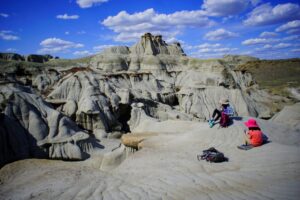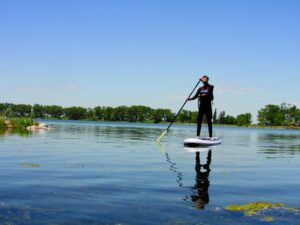
淺談觀光旅遊產業與休閒娛樂之系統整合規劃:以加拿大艾伯塔省州立公園為例
Adrian 和 Adrian (1998) 將系統規劃定義為「一種有組織的宏觀規劃方法。

它不是一個新概念,而是建立在現有知識和方法的基礎上。 系統規劃是理解和使用系統思想的框架。 它也是說服他人的工具。 它不僅僅是數據收集。 這必須是一個動態的過程。」一般來說,系統計劃為保護區組織內的所有組成部分以及保護區與該地區土地利用、資源管理和社會發展的其他方面的協調提供方向和指導。 系統計劃包括保護區的歷史、現狀和未來計劃(Adrian & Adrian 1998)。
Adrian and Adrian (1998) define system planning as “an organized approach to macro-level planning. It is not a new concept, but builds on existing knowledge and approaches. System planning is a framework for understanding and using systems ideas. It is also a vehicle for convincing others. It is much more than data gathering. It must be a dynamic process.” Generally, a system plan provides direction and guidance for all components within a protected area’s organization and the coordination of protected areas with other aspects of land use, resources management, and social development in the region. A system plan includes the history, present condition, and future plan for the protected areas (Adrian & Adrian 1998).

系統規劃對於廣泛地理區域的管理和開發非常重要。當應用於公園和保護區時,系統規劃為協調整個保護區系統的土地利用和社會發展平衡的機制、制度和程序提供指導(Adrian & Adrian,1998)。傳統上,系統規劃集中在論公園系統內的生物地理表徵。相反地,它忽視了旅遊和娛樂的組成部分。管理的主要目標加拿大國家公園的重點是保護和維護生態完整性。同樣,安大略公園的系統規劃基於生物地理概念,即該省的森林地區。不列顛哥倫比亞省的保護區系統也基於代表自然區域類別的原則。這些系統計劃都沒有建立基於旅遊或娛樂原則的公園創建和管理目標。
System planning is important to the management and development of broad geographical areas. When applied to parks and protected areas, system planning provides guidance on mechanisms, institutions, and procedures to coordinate the balance of land use and social development across a system of protected areas (Adrian & Adrian 1998). Traditionally, system planning concentrated on biogeographic representation within a park system. Conversely, it neglected tourism and recreation components. The main goal in the management of Canada’s National Parks is the protection and maintenance of ecological integrity. Similarly, the Ontario Parks’ system plan is based upon a biogeographical concept, the forest regions of the province. The province of British Columbia’s protected areas system is also based upon a principle of representing classes of natural areas. None of these system plans establish goals for the creation and management of parks based on tourism or recreation principles.


鑑於旅遊和休閒對加拿大公園運動的重要性,戰略規劃者有必要在下一代公園系統規劃中更充分地考慮這些概念。艾伯塔省擁有完善和成熟的保護區系統。該省經濟和人口的快速增長,以及社會對艾伯塔省保護區旅遊和娛樂機會的需求不斷增加,需要在系統規劃中進行額外的戰略考慮。 因此,本文的重點是為基於阿爾伯塔公園和保護區的休閒和旅遊目標和目標的保護區系統計劃制定一個概念框架。舉例來說,艾伯塔公園和受保護系統,包括國家公園、省公園和保護區,現在超過 8,160,300 公頃,約佔全省面積的 12.3%。
Given the importance of tourism and recreation to the park movement in Canada, it behooves strategic planners to more fully consider these concepts in the next generation of park system plans. Alberta has a well-established and mature protected areas system. The rapid economic and population growth of the province, and the increasing demands from society for tourism and recreation opportunities in Alberta’s protected areas, creates a need for additional strategic considerations in system planning. Therefore, the focus of this paper is to develop a conceptual framework for a protected area system plan based on recreation and tourism goals and objectives for Alberta Parks and Protected Areas. The protected area system in Alberta, including National Parks and Provincial Parks and Protected Areas, now exceeds 8,160,300 hectares or approximately 12.3 percent of the province.

艾伯塔公園的系統規劃將全省劃分為六個自然區域:1) 白楊公園地、2) 北方森林、3) 加拿大地盾、4) 草原、5) 山麓和 6) 洛磯山脈。在每個自然區域內,艾伯塔公園都建立了從低強度到高強度使用的保護區網絡。八類保護區省內包括:1)威爾莫爾荒野公園,2)生態保護區,3)荒野地區,4)遺產牧場,5)荒地公園,6)省級公園,7)自然保護區,8)省級休閒區。這些區域為遊客提供了參與遺產欣賞、戶外休閒活動和遺產旅遊的機會。保護——永久保護代表該省自然遺產和相關文化遺產多樣性的公園和保護區網絡。
The system plan for Alberta Parks divides the province into six natural regions: 1) Aspen Parkland, 2) Boreal Forest, 3) Canadian Shield, 4) Grassland, 5) Foothills, and 6) Rocky Mountains. Within each of these natural regions, Alberta Parks has established a network of protected areas ranging from low intensity to high intensity use. The eight protected area classes in the province include: 1) Willmore Wilderness Park, 2) ecological reserves, 3) wilderness areas, 4) heritage rangelands, 5) wildland parks, 6) provincial parks, 7) natural areas, and 8) provincial recreation areas. These s, 7) natural areas, and 8) provincial recreation areas. These areas provide visitors with the opportunity to participate in heritage appreciation, outdoor recreational activities, and heritage tourism. The four goals of Alberta’s network of parks and protected areas are: 1. Preservation – to preserve, in perpetuity, a network of parks and protected areas that represent the diversity of the province’s natural heritage and related cultural heritage.


遺產鑑賞 – 提供機會探索、理解和欣賞艾伯塔省的自然遺產,並提高公眾對我們與自然世界的關係和依賴的認識。戶外休閒——提供各種依賴自然景觀的戶外休閒機會及相關設施和服務。第一個目標,保護,是艾伯塔公園現有系統計劃的主要重點。這一目標是通過創建許多公園來實現的,並受到保護1995 年至 1999 年特殊場所計劃期間的區域。該計劃為系統增加了 81 個新公園,並擴展了 13 個現有場地,為系統增加了 2,000,000 多公頃(Alberta Parks 2006b)。在撰寫本文時,艾伯塔省的保護區系統還沒有涉及遺產欣賞、戶外休閒和遺產旅遊目標的實施的戰略計劃。公園管理機構的規劃者和公園學者都承認這種政策無效。
Heritage Appreciation – to provide opportunities to explore, understand, and appreciate Alberta’s natural heritage, and to enhance public awareness of our relationship to and dependence upon the natural world. Outdoor Recreation – to provide a variety of natural landscape-dependent outdoor recreation opportunities and related facilities and services.The first goal, preservation, is the main focus of Alberta Parks’ existing system plan. This goal was implemented through the creation of many parks and protected areas during the Special Places Program from 1995 to 1999. This program added 81 new parks to the system, and expanded 13 existing sites for an addition of over 2,000,000 hectares to the system (Alberta Parks 2006b). At the time this paper was written, there was no strategic plan for Alberta’s protected areas system dealing with the implementation of the goals of heritage appreciation, outdoor recreation, and heritage tourism. This policy void is recognized by planners with the park agency and by parks’ scholars.

將目標定義為,「廣泛的建立保護區的既定社會目的」和「目標是對要完成什麼的更明確的陳述」。目標是子目標,提供更明確的說明來完成。 Schoemaker (1984) 提供了五個基本特徵,從中可以系統地構建目標:1) 以產出為導向,2) 有時間限制,3) 具體的,4) 可衡量的,以及 5) 可實現的。 “以產出為導向”是指目標通過描述要完成的事情而不是如何完成來處理活動的結果。有時限的目標為製定適當的管理行動提供了方向,並要求問責。具體目標應為所有各方提供要完成的工作的清晰願景。可衡量的目標為評估進展提供了明確的基礎,並使管理人員能夠確定未來需要努力的地方。 「可實現」意味著目標必須可以通過可用的資金和人員資源實現,有時會在理想主義的願景和旅遊影響的現實之間做出妥協(Zealand 等人,2005 年)。所有目標和目的的措辭都應具有這些特徵。
Eagles et al. (2002) define goals as, “the broadly stated social purposes for which a protected areas is established” and “objectives are more explicit statements of what is to be accomplished.” Objectives are sub-goals that provide more explicit statements of what is to be accomplished. Schoemaker (1984) provided fi ve foundational characteristics from which to systematically construct objectives: 1) output-oriented, 2) time-bound, 3) specifi c, 4) measurable, and 5) attainable. “Output-oriented” means that objectives deal with the results of an activity by describing what is to be accomplished, but not how. Time-bound objectives provide the direction to develop the appropriate management actions, and require accountability. Specific objectives should provide all parties with a clear vision of what is to be accomplished. Measurable objectives provide a clear basis for evaluating progress and allow managers to determine where efforts need to be placed in the future. “Attainable” suggests that objectives must be achievable with the available funding and staffing resources, sometimes compromising between the idealistic vision and the reality of the impacts of tourism (Zealand et al. 2005). All goals and objectives should be worded so as to have these characteristics.
文/Paul F.J. Eagles
提供/Prof. Markus Pillmayer
圖/Website Resource
























